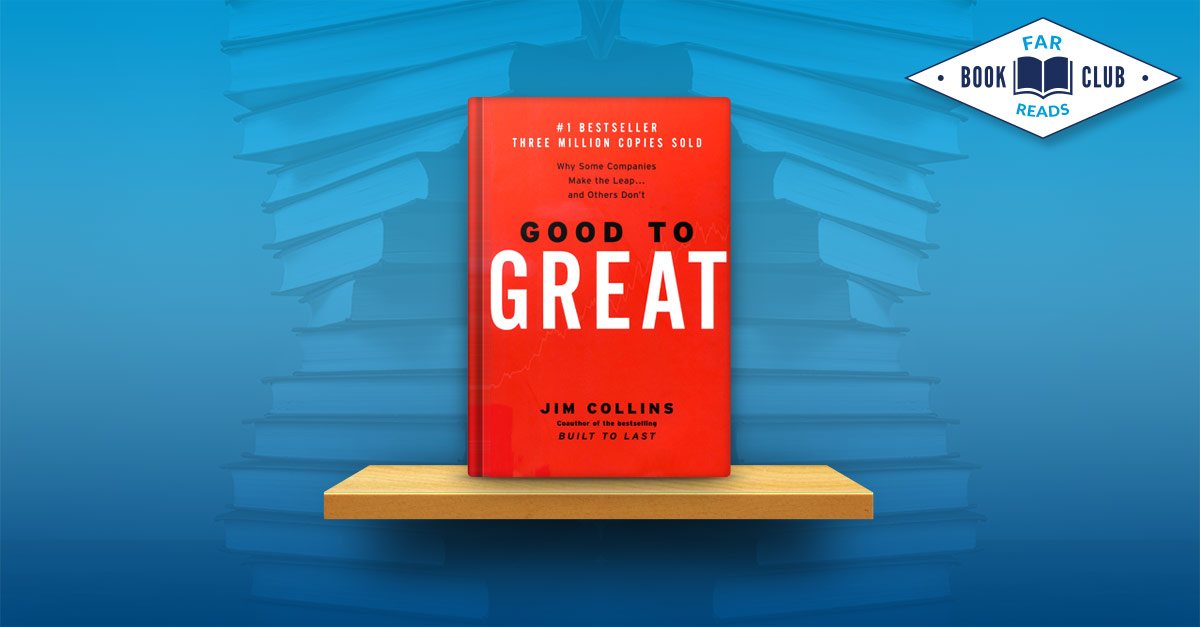
This month’s Far Reads book club pick was “Good to Great” by Jim Collins. Here’s our recap.
Who Selected It
Chad Feldmann
Why He Selected It
“‘Good to Great’ has been on my to-read list for several years. Whenever I read a list of top 10 business books, it’s always on there. Also, I want to see Far Reach become great. I thought this book, like past books we’ve read, could be transformative for our team.”
What It’s About
Can a good company become a great company? And, if so, how? That’s what Jim Collins and his team of researchers wanted to find out.
The good news: The answer is yes.
The great news: They discovered seven timeless principles that can be applied to any organization, including yours.
Companies that made the leap to greatness followed these seven principles:
- Level 5 Leadership – Good-to-great companies had a Level 5 leader—someone who builds enduring greatness through a paradoxical mix of personal humility and professional will.
- First Who…Then What – Good-to-great leaders first got the right people on the bus (and the wrong people off the bus) and then figured out where to drive it.
- Confront the Brutal Facts (Stockdale Paradox) – Good-to-great companies found a path to greatness by confronting the brutal facts of their current reality.
- Hedgehog Concept – Good-to-great companies were like hedgehogs—simple, dowdy creatures that know “one big thing” and stick to it.
- Culture of Discipline – Good-to-great companies hired self-disciplined people who didn’t need to be managed, and then managed the system, not the people.
- Technology Accelerators – Good-to-great companies used technology as an accelerator of momentum, not a creator of it.
- Flywheel, Not Doom Loop – Good-to-great companies didn’t have a defining moment that led to greatness; instead, it came about through a cumulative process.
As you read “Good to Great,” you may be surprised by what companies did (and didn’t) make the list, as well as by insights contrary to conventional wisdom.
Our Favorite Quote
“In training, Scott (Dave Scott, who won the Hawaii Ironman Triathlon six times) would ride his bike 75 miles, swim 20,000 meters, and run 17 miles—on average, every single day. Dave Scott did not have a weight problem! Yet he believed that a low-fat, high carbohydrate diet would give him an extra edge. So, Dave Scott—a man who literally burned at least 5,000 calories a day in training—would literally rinse his cottage cheese to get the extra fat off. Now, there is no evidence that he absolutely needed to rinse his cottage cheese to win the Ironman; that’s not the point of the story. The point is that rinsing his cottage cheese was simply one more small step that he believed would make him just that much better, one more small step added to all the other small steps to create a consistent program of superdiscipline.”
How We’re Applying What We Learned
So, how does Far Reach make the transition from good to great?
One thing we need to do is identify our flagship product. (The author said good-to-great companies have one.) In other words, what can we be the best at in the world? How do we differentiate ourselves from the thousands of companies that offer the same products and services we do?
Discipline is another area of focus. That theme came up in this book and has come up in almost all the books we’ve read.
Finally, we need to do a better job of, as the author put it, facing the brutal facts. We need to acknowledge issues rather than hide from them—as uncomfortable as they may be— so we can work through them as a team.